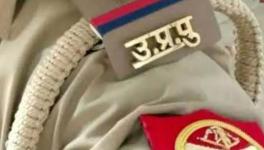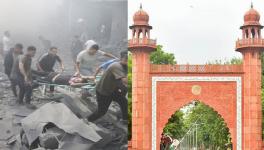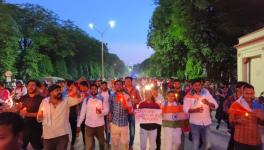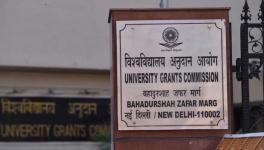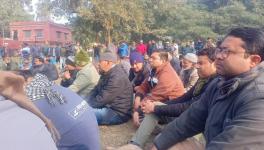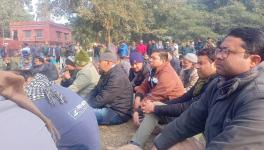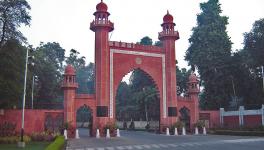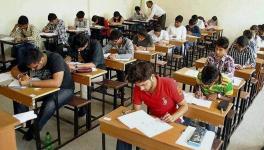AMU Police Brutality Brings Aligarh’s Muslims, Hindus Closer
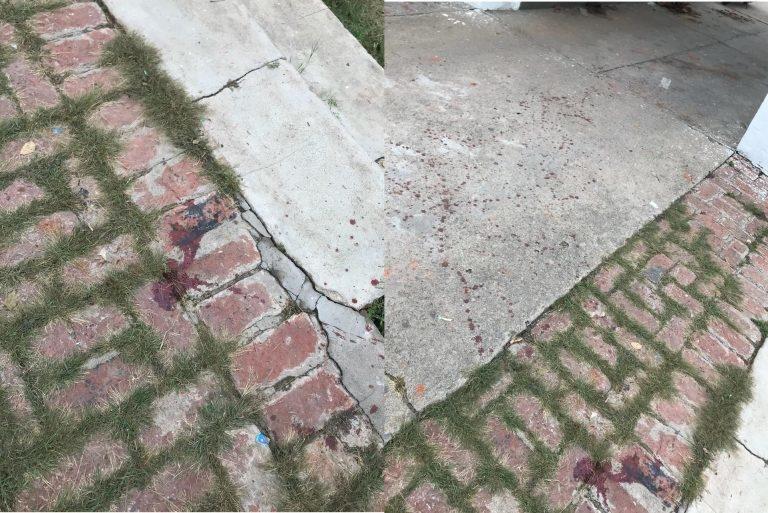
Blood spatters seen on campus
On the evening of December 15, the students of Aligarh Muslim University (AMU) faced the most brutal police violence in recent history. AMU’s administration had called in the police to control agitating students, who, since December 12, had organised a mass protest against the Citizenship Amendment Act, 2019 (CAA). This Act is considered unconstitutional, for it defines citizenship on the basis of religion and it excludes Muslims from its purview.
Simmering anger had been sparked among the students by a rumour that one student of Jamia Millia Islamia in Delhi had succumbed to injuries inflicted by the police on the night of December 12. The students of Jamia had also been agitating against the CAA. The anger of AMU students increased manifold on the evening of December 15, when visuals of vandalism by a marauding police force in Jamia flooded the social media and television channels. The visuals showed the destruction of libraries and the mosque inside the Jamia campus by the police.
India’s amended citizenship law is contrary to the relevant international laws, as evidenced by the fact that our neighbouring countries, such as Sri Lanka, whose Tamil minorities face persecution from the Sinhala Buddhist majority or Myanmar, where Rohingyas face persecution from Buddhists or Tibetan Buddhists, Nepal and Bhutan, have been excluded from the protections offered by the Act. Only non-Muslims coming from just three Muslim-majority countries in the neighbourhood are referred to in India’s new citizenship law.
The CAA has followed the National Register of Citizenship or NRC exercise in Assam, which declared lakhs of Hindus non-citizens in August this year. The blatantly discriminatory gesture of the Bharatiya Janata Party (BJP) government at the Centre is that it has announced that the non-Muslims excluded by the NRC in Assam would be granted citizenship through CAA, but not the Muslims.
News stories of detention camps being erected in Assam and in Karnataka, and elsewhere, are adding to the fears of India’s Muslims. The pretext of the violence unleashed by Delhi Police on students of Jamia was an allegation that surfaced on December 15, that the agitators had set ablaze a bus. The buses were parked roughly two kilometres away from the campus, while the police entered the university and assaulted the students.
The visuals shared on social media suggest that it was probably the police that set the bus on fire to create a pretext to crush the students whose agitation against the CAA was proving to be an embarrassment for the ruling Bharatiya Janata Party (BJP). Fierce agitations against the CAA across the North-East has already put the BJP government in the dock. There is a belief among a large number of Muslims that the mysterious Godhra train-burning of February 2002 was used as a pretext for the anti-Muslim pogrom in Gujarat. There is also suspicion that the bus set ablaze near Jamia was to manufacture a reason to unleash violence against students.
In these circumstances, the rumour of a student’s death further fuelled the rage among AMU students. Otherwise, from December 12-15, the agitation in AMU was quite peaceful and all criticisms, placards and slogans were being articulated in Constitutional language.
On the evening of December 15, however, the angry mob was infiltrated by some elements who insisted on making the AMU agitation Muslim-specific. They introduced slogans such as “Nara-e-Takbir/Allah-u-Akbar”. This group also wanted to break open the main gate of the university, which was the dharna site, so as to offer the janaaza, or last prayer, for the student who was rumoured to have died in Jamia. In the stone-pelting that ensued, a senior police officer was injured.
The AMU administration maintains that it was now left with no option but to allow the police to handle the situation. However, never before had the police entered the hostels of AMU using weapons such as stun-grenades, rubber bullets and tear-gas shells. They entered the hostels that are located far from the main entrance gate where the agitating students had gathered for their dharna.
The police allegedly shot a large number of students in the head and chest. Some students had taken shelter inside the two guest houses of AMU, which are located close to the main entrance gate. The next morning, these two guest houses were found badly ransacked. Video footage taken by journalists and students and the CCTV footage suggest that the police had resorted to vandalism in AMU, just as they had in Jamia, Delhi.
For example, AMU teachers found the floor of the guesthouses splattered with bloodstains everywhere.
As many as 27 youngsters, including seven bona fide AMU students, were picked up from hostel rooms and guesthouses. The police literally smoked out a few students from one particular room, (number 35) of the Morrisson court hostel. They were taken into custody even though they were severely injured.
Late at night on December 16, when 23 of the detained young people were released, none of them was able to walk. All of them were severely injured. At least one student has lost the palm of his hand. Another is critically injured, and is now being treated at Sir Ganga Ram Hospital in Delhi.
The students were released by the police after almost 22 hours in custody. Most of them are undergoing treatment at AMU’s Jawaharlal Nehru Medical College and Hospital, next to the campus. The police did not produce any of them before a magistrate, hence their detention remains illegal.
These students have given statements to civil rights activists and to their friends and teachers that while in police custody they were stripped naked in this extreme cold winter, and then brutally thrashed. They said the police also hurled anti-Muslim slurs on them and they were forced to shout ‘Jai Shri Ram’ and were even called terrorists. The Kashmiri students alleged after their release that they were thrashed even more cruelly, and some men even urinated into their mouths.
The hands and legs of many students were fractured in the police action. Notably, the students who happened to be Hindu were spared by the police during custody and were also released instantly. These accounts clearly reveal the deep anti-Muslim bias of Uttar Pradesh’s police force.
Students are particularly angry against the AMU administration for having called the police. AMU functionaries maintain that some anti-social elements had entered their protest, who were likely to make the protest violent. Some students admit that a handful of Islamic Right-wing students had entered the agitation and tried to take advantage of the rumoured death of a student in Jamia.
In fact, the scuffle that erupted at the main entrance gate of AMU is being seen as a justification for the administration to allow the police to wreak havoc on the campus. This justification is not being accepted by the parents or the students, nor by the local population of Aligarh.
After the protests, AMU advanced the date of winter vacations by less than a week, postponed the scheduled exams and forced students to evacuate the hostels. This has added to the anger of the parents and students, for, given the extreme religious polarisation, the traveling students now run the risk of violence at the hands of Hindutva zealots as well as the police. This risk is even higher for students from North-East and Kashmir, where curfew-like situations already prevail.
The managers of governance at AMU need to realise that this is not just another student agitation. Nor is it on a student-specific issue. It is, therefore, unlikely to be short-lived. This is an agitation against a law which seeks to deprive a large population of its citizenship of their rights. Students are fighting a cause not only for themselves but for the larger citizenry. The AMU administration, therefore, should not even be remotely seen as crushing the agitation in order to help the party in power.
Pre-Existing Discontent Against AMUTA
Discontent has been brewing against the AMU Teachers Association (AMUTA) for very long. The association has not held any talks, lectures or debates to discuss how the NRC, the pre-existing citizenship legislations, the National Population Register (NPR) and the Census are inter-linked. A comprehensive and informed discussion on these issues may have helped allay misgivings over the issue, which is quite confusing as of now.
This confusion has already put people in a state of extreme anxiety. Despite popular demand from teachers, AMUTA has been avoiding a debate or discussion or talk on the burning issue.
Against the alleged forceful evacuation of hostels at AMU, women members of the families of AMU staff, who reside on the campus, are also angry. Various groups of civil rights activists have visited the campus to prepare fact-finding reports on the whole incident.
The aggrieved students and their parents are demanding a time-bound, impartial judicial inquiry into the episode, including the police excesses and adequate compensation for the injured students.
Against this persecution of students, the people of the city of Aligarh, also joined by a section of poor Hindus, have staged huge protests, both in the city and inside the university campus. It is these protests that mounted pressure on Aligarh Police to release the students it had detained.
Subaltern Muslims who live close to the AMU campus told this writer that they do not usually speak out or protest because the Hindus get polarised. For this reason, their leaders have been advising them to be quiet. Some told me that they had wanted to protest against the Ayodhya verdict of the Supreme Court. They wanted to demand that a school or hospital be built where the mosque once stood in Ayodhya. They wanted to tell the Hindus in Ayodhya to build their temple on the five-acre plot that the Supreme Court has given to Muslims. But their leadership dissuaded them from speaking out.
Now, with their citizenship at threat, Indian Muslims feel that this is their final battle. If crushed, they will not be able to rise again.
The city population, including poor Hindus, also feel that AMU students were fighting their battle for citizenship. They feel that the students were demanding self-respect of all citizens, not just for themselves. They wonder why they are being inflicted with the humiliation of having to prove their citizenship. These people, along with the students, are still continuing with their dharna at AMU, even after 90-95% of the resident students have been made to leave the hostel.
A Historic Opportunity Hindus Must Not Miss
Non-Muslims also have to undergo the painful process of collecting and producing the documents of citizenship. The landless and property-less people of all religions will face an acute problem due to lack of documents.
Yet, the leaders who invoke the names of Ram Manohar Lohiya, Ambedkar, Mandal and Birsa Munda, have not gone amongst the masses to make them aware of the pain and humiliation that proving their citizenship will entail. The ruling dispensation seems to have developed a psychological disorder wherein they repeatedly find pretexts to force people to stand in long queues – be it for demonetisation, for getting their traffic-related documents in order at the last moment. Now, the same is being proposed for NRC.
The electorate needs to see through these sadistic games being played by the regime.
In the political history of the Indian Republic, it is probably for the first time that the Muslim citizenry has stepped out on the streets for citizenship rights, the values enshrined in the Constitution and for a secular definition of citizenship. Earlier, their mass protests veered mainly around identity-related issues of personal law, and against gender reforms. This agitation offers a massive and historic opportunity to all well-meaning Hindus. They must extend their support to strengthen and deepen the secularisation of the Indian citizenry.
The Hindus who are willing to extend their support must learn the right lessons from Pakistan’s experience; where Muslim majoritarianism has ruined and devastated the society, polity and the economy. Having declared itself an Islamic nation, the Pakistan state has constantly been engaged in finding new target groups whom it can declare “non-Muslims” within its borders—such as the Ahmediyas, the Shias, the Muhajirs, the Balochis, and so on. These groups are then either turned into unequal citizens or excluded from citizenship rights.
During the anti-colonial struggle, India visualised an inclusive, pluralistic society. Persecuting minorities and harbouring hatred against them are not at all nationalistic. A complete civil disobedience against the discriminatory, divisive, hate-filled, majoritarian and possibly autocratic exercise of NRC must, therefore, be launched by every Indian.
That will be true nationalism.
The writer teaches history at Aligarh Muslim University. The views are personal.
Get the latest reports & analysis with people's perspective on Protests, movements & deep analytical videos, discussions of the current affairs in your Telegram app. Subscribe to NewsClick's Telegram channel & get Real-Time updates on stories, as they get published on our website.









